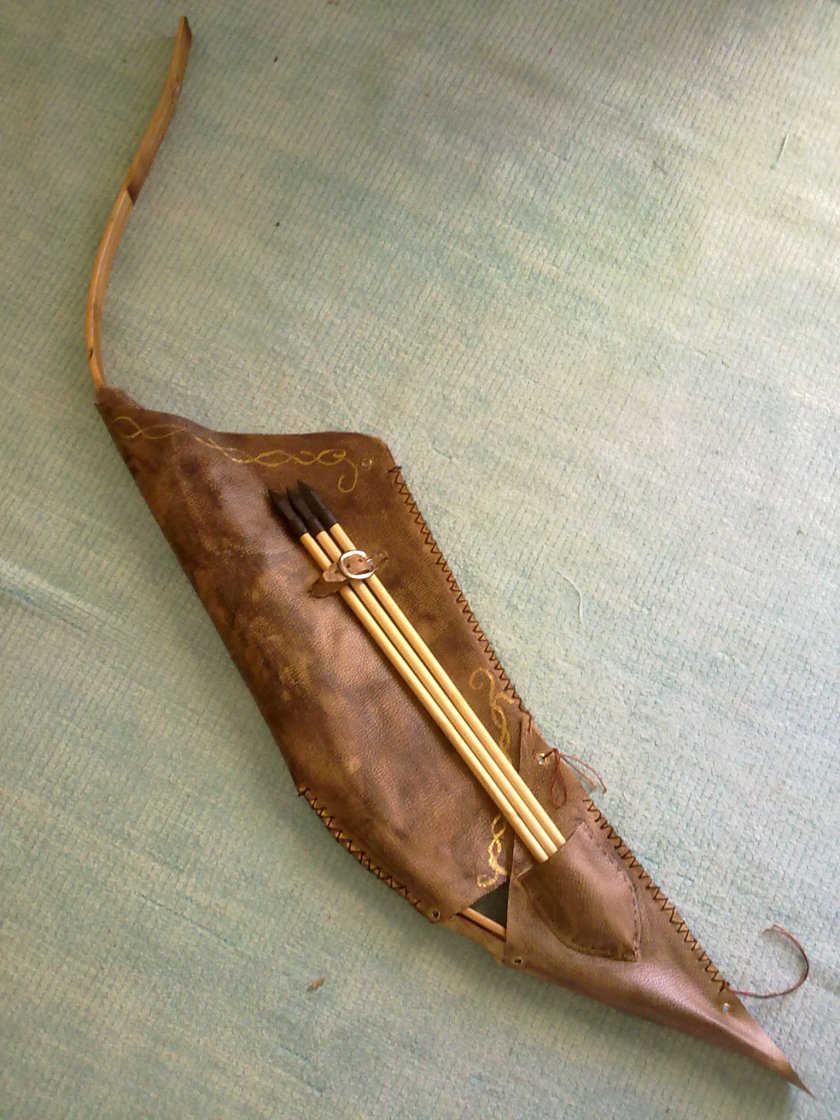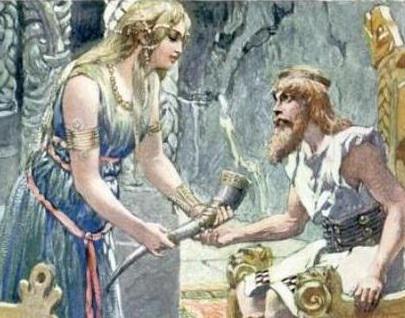This is a conversation we had with the anthropologist and shaman Alver Hviti on how to practice the Old Ways in today’s world.
WR:“We live in a tolerant society. In this day and age it is easy to be a pagan. Politicians and the media preach religious freedom all the time. Would you agree?”
AH:“It might come to a great surprise to many that, in this day and age, there is a great hostility towards Norse pagans in Europe. There is freedom for what is deemed the ‘ideal faith’ but this does not include Fon Sið. This is due to the use of our iconography by a tyrannic totalitarian regime and by hate groups, and also the rising Islamization of Europe”
WR:“Will the situation be better in the future?”
AH:“It will be worse. Following our ancestral faith may mean a death sentence in the near future – in certain countries, it already means getting a beating for being mistaken with extremist far right group members, and who can forget what the sharia Islamic religious law, prescribes for non Muslims who don’t follow the “Religions of the Book”? Yes, the sentence is death, by the way…”
WR:”What can be done about this?”
AH:”The only safe way to practice our religion is to hide in plane sight. I have taken upon myself, both as an anthropologist by training, and as a concerned member of a possibly endangered population, to write a guide for the followers of the Old Ways to do this.”
WR: “What does this mean? To hide in plain sight?”
AH:”Let me explain this from a historical perspective.
The Christianization of the Vikings is rumored to have started around 826 CE, with the conversion to Christianity of Harald Klak, King of Jutland, but the ensuring tale is somewhat foggy at best, having been heavily adulterated in order to mirror our sagas to stimulate conversion by making the missionaries’ stories similar to ancient Norse legend.
What is true and can be attested is that somewhere in King Olaf Tryggvason’s rule – Or Saint Olaf as he was known to Christians back then – Christianity was spread by sword and axe, culminating in the 18th century with a final mission to Christianize the last pagan remnants in Greenland, and the Sami folk who may have been the original Vanir tribe.”
WR:“How did the original Heathenism survive – in any degree – during eight centuries to repeated attempts of eradication?”
AH:”To explain this, I would like to present a more recent, and yet distant example of an indigenous faith which not only survived forced christianization, but is still followed today by thousands of individuals. I am talking of Umbanda and Candomblé, two syncretic religions originating in both the Banto and Yoruba faiths of the African slaves ferried to Brazil in the period between 1501-1806 CE.
Before being sent to Brazil and formally sold to their masters after being captured by enemy tribes in Africa and sold to the Portuguese and Spanish, the Yoruba and Banto prisoners were forcefully catechized and baptized as Christians since that would increase the slave’s trade value. In order to keep their ancestral faiths alive, they created an outside mask, disguising their native deities as Christian figures, and their rituals as Christian ones.
So, their Mother Goddess, Iemanjá, became Holy Mary, mother of Christ. Xangô became both St Jerome and St Barbara, Oba – Xangô’s wife/consort – became St Catherine of Siena.
Religious structure is predominantly matriarchal since women stayed indoors, caring for the kids and would pass on their faith: Female religious leaders, and sometimes male – Mães de Santo and Pais de Santo – lead worship and teach the next generations, although not surprisingly, when Yoruba slaves were sold and forcefully converted to Islam, they would also create syncretic links to keep their faith whilst their Muslim masters would think them submissive to Islam. These communities would be Patriarchal in order to disguise Pais de Santo as Muslim Imams and would syncretize their deities into Djinn, islamic Genies.
As a result, their faith survived up to today, and is still in relative growth in Latin America and certain areas of Africa such as Malawi and Liberia.”
WR: “What about the Ancient Norse? Did they use syncretism?”
AH: “Syncretism was the solution the Ancient Norse too found to safeguard their faith for 800 years, and the proof is evident in the 16th Century Galdrabok, a collection of grimoires – spellbooks – which reveal a marked syncretic faith mixing both ancient heathenism with Christian mythology whilst using runes and Norse galdur enchantments….not to mention the archaeological evidence of several Mjolnir pendants made in such a way that they could double as both Mjolnir and the Christian Cross, such as the Yorkshire Thor Hammer, now in the Schoyen Collection tagged as the item MS 1708, and the small silver hammer found at Fossi, Iceland, belonging now to the National Museum of Iceland’s collection.
Now, in order to save Heathenism from possible future persecutions, we can discern two routes, both having at their core a simple principle: Hiding.
Either by hiding in a wood to perform Blotar, or by creating syncretic analogies between Heathenism and the local dominant faith, one may hide in plane sight.
As I previously mentioned, both this techniques seem to have been taken by our forefathers, in particular when one recalls the amount of myths about “red fairies” and “blood mounds ” perpetrated by Christians in Iceland and Denmark, usually referring to places which were in the past stages for blotar which, undefiled by the priests and due to their remote locations were probably in use long after christianization.
We can also mention the alleged founding legend of the so called Brotherhood of Odin: the burning of a heathen widow whilst her two sons and daughter were forced to watch then convert publicly to Christianity, leading those children to adopt a double life like any person trapped in such situation: as anyone could see, in their public lives, they became good Christians, but secretly assembled a group of heathens who would gather in groves and woods to worship the ancient Gods.”
WR: ”The Brotherhood of Odin seems to be a fabrication”
AH: “This is true. However many fabrications have an element of truth in them.”
WR: “Sometimes the fabrications are better than the original: the Essene Gospel of Peace for example.”
AH: “Indeed.The Brotherhood of Odin was ‘discovered’ by Mark Mirabello, a professor of history who was researching his PhD and later in ’92 wrote the book that may have turned his construct into reality (if it wasn’t before) and the tale seems plausible, specially when one is reminded that the ancient Celts did the same in Ireland and Britain with their own faith.”
WR:”How do you prevent the Mother belief being unmasked?”
AH: “It is a mistake to bring too much of the original faith into the syncretic form. One must focus on the essential and essentials alone. On the other hand bringing too little will lead to the Original Faith disappearing.”
After the essential elements are isolated, one must create the syncretic links: choosing venerable entities to serve as masks for the essentials. Usually, the criteria to choose them would rest on the potential mask’s attributes.
In a short example, when disguising the traditional Fon Sið as Christianism:
Balder becomes Christ (The resurrected son of the major god)
Frigga becomes Mary (representation of the sacred feminine in Christian mythology)
Odin becomes God the Father (since most Asatruar consider him as a chief deity)
Hod becomes St Longinus (Because Longinus stabbed Jesus with a spear whilst Hodr stabbed Balder with a missletoe arrow, see the paralel?)
Loki becomes Lucifer (The fallen angel who started as a trickster, then became evil).
And so on for other associations.
Blotar and Sumbeler, which are usually composed of a series of toasts, some with mead spilled in the ground as offering, others without. In order to hide Blot as a plane sight practice, a few elements would have to be changed, such as the spilling and the drinking horns. Those would have to be replaced by normal cups, and the invocations whispered into them as folk would pretend to be toasting each other.
Hammers may be disguised as crosses, and the popular Tree of Life designs that populate today’s trinket stores can be appropriated in representation of Yggdrasil, specially in those versions that depict the tree upside down.
WR: “What about in an Islamic setting?”
AH:”Unfortunatly, when it comes to attempt to hide in an Islamic setting, life gets harder for us. Any sort of alcoholic beverage (including mead) is strictly forbidden, not to mention any representation of living beings (including trees) is also forbidden because it is considered to lead to idolatry. Similarly, there is little to nothing on the mainstream creed one can grasp on to create syncretic links, but Islamic folklore gives you a way out: Djinns.”
WR: What are Djinns?
AH:”Djinns are “genies”, a form of demons in Islamic lore. Djins are reported to have their own culture and follow the faiths of Man, being easily “adapted” as syncretic links, allowing one to appear muslim, yet worshiping the Old Gods.
As for Blot and Sumbel, Islamic Law prescribes two times one must make a symbolic sacrifice – the Eid celebrations. In both Eid, one is supposed to kill a sheep or lamb, and make a huge celebration to commemorate the end of Ramadan. Since Blot cannot be made with mead in a muslim setting, why not making it the old fashioned way with blood?
Sumbel is a practice that would, unfortunately have to be hidden, taking place in one’s basement or a closed windowed room. Make sure someone stays as a lookout, though, case a “friendly” neighbor decides to denounce you to the authorities!
Trickier practices to hide would be Seidr and Galdr.
Galdr, ironically already has a mirror in Islamic countries: Taweez pendants.
These are hollow, cylinder like pendants which as supposed to be filled with Dua – special prayers meant to request something – and used around one’s wrist or as a necklace. BUT…..who says that it has to have Duas inside and not a galdr? Nobody will peek inside the box.
Seidr, on other hand, falls into the same category as Sumbel – has to be hidden from semi-public view and conducted in basements and suchlike.
These are merely small suggestions which have vast field to be improved. Suggestions on commentary are welcomed.”
Webgraphy:
https://cefeco.wordpress.com/2013/02/15/a-influencia-de-costumes-islamicos-no-candomble-e-na-umbanda/ retrived in 29/8/17
http://www.ravenkindred.com/RBRituals.html retrived in 29/8/17
https://en.wikipedia.org/wiki/Ta%27wiz
https://www.utsavpedia.com/cultural-connections/mythological-influences/taweez-religious-pendant/
WR: “What about the Chinese religion?”
AH: “There are many similarities with Fon Sið. Ancestor worship for example. The Chinese often display photograph of their ancestors, perhaps on an altar. So just put photos of your own ancestors on an altar or other sacred place.”
WR:” What about the gods?”
AH:” Lao Tsu is an avatar of Odin possibly. There are many similarities. He is an old man of great wisdom who is shrouded in mystery. There is much wisdom in the Tao Te Ching.
The offerings made to the ancestors and Immortals on special occasions, generally of food and drink, are a form of Blotar.”
WR: “Is mead offered?”
AH: “No. Generally a drink of red color.”
WR: “Such as?”
AH: “Anything, just provided it is red. Sometimes red fanta is used. However one could use mead instead.”
WR: “When are these offerings made?”
AH: “On special occasions such as an ancestors birthday or the day they passed away. This fits perfectly with Fon Sið and is something we should be doing anyway. Just substitute mead instead of the red drink.”
WR: “What about Buddhism?”
AH: “Buddhism is a goldmine of information about the Indo-European religions. Buddha was a reformer who wanted to return the the original root religion from which Fon Sið is a branch. Therefore we can learn a lot from Buddhism.”
WR: “I have heard a theory that Odin and Buddha were the same person”
AH: “Sir William Jones, first suggested this, on etymological grounds . And there are obvious similarities between Buddha finding enlightenment under the Bodhi tree and Odin finding the meaning of the runes hanging from the tree of Yggdrasil.
Meditation for a Norse pagan could take the form of visualizing the runes, in the same way that some Buddhists meditate on a mandala,
The 5 precepts that Buddhist lay people take are an excellent code for living for people of any faith. The Daoists for example live by the 5 precepts.”
WR: “What other similarities are there?”
AH :”Many. Buddhist cosmology is compatible with Norse cosmology just using different language. The Norse gods would be devas in the Buddhist system. The concept of Hel is the same. Valhalla is Nirvana, although described in a way that would be appealing to the Viking warlords, certainly in the form that has come down to us. Wights elves, trolls would be ghosts or devas in Buddhist terminology. Buddhists would have no problem relating to these entities.”
WR: “What about Ragnarok?”
AH: “In Buddhism the end of the world comes as the sun gets hotter and hotter and the world ends. Eventually even the devas (ie gods) perish so the idea is the same.“




